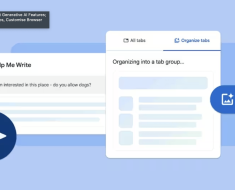In the early 2000s, the talk of the Consumer Electronics Show was internet-enabled microwaves, dishwashers, fridges, and other home appliances. The possibilities of having these devices connected to the internet— reminiscent of the Jetsons—seemed like an exciting wave of the future.
Over two decades later, however, it’s unlikely that you know anyone who owns an internet-enabled dishwasher, much less an entire kitchen. So, what went wrong? Essentially, those fancy new smart appliances weren’t widely adopted because they weren’t created to solve a customer problem. Instead of focusing on functionality, the makers of these devices focused on conducting tech for tech’s sake, or a type of “science” project. Today, they are museum pieces, remembered by few and owned by even fewer.
The value of artificial intelligence
The hype around generative artificial intelligence (AI) is loud and building every day. As with earlier major technological transitions, such as the internet and the cloud, we know that artificial intelligence, machine learning, and generative AI the ability to bring about large, industry-wide change. But if we focus too much on the tools and not the problems, we run the risk of wasting our resources on fancy science projects.
Instead of getting lost in the discourse, CEOs and board members of small to medium-sized businesses (SMBs) should ask themselves: What does generative AI mean for my business? How will generative AI affect my company’s existing value proposition? How will it affect my customers’ value proposition—and when will we see its effects? How will generative AI change my business model? And is my organization ready for these changes?
It’s much to think about—and it’s important to understand that these are basic business questions. These same questions were asked whenever a new technology has been introduced to the market. When the internet emerged or when the cloud was introduced, we also wondered: How will this new, exciting tool affect my business, change what we do, and transform customer expectations? How will this new thing strengthen my value proposition?
Companies that treated these queries as business questions tended to have very different outcomes than those that didn’t.
Using technology to solve pain points
In 2002, FedEx noted that the paperwork their 40,000 FedEx Express couriers were required to file each time they picked up or delivered one of the 3.5 million packages they collectively interacted with daily was resulting in time lost. The company partnered with Motorola, Inc. to develop the FedEx PowerPad handhelds, a custom-made device designed to eliminate the need for FedEx Express couriers to do paperwork, ultimately saving them 10 seconds at each stop. The $150 million investment was projected to save the company approximately $20 million per year.
Netflix also used technology to improve their value proposition. Seeing that customers were unhappy about incurring late fees, Netflix created a mail-in model without late fees. Then, when cloud technology developed, Netflix did something courageous. They disrupted themselves, switching from their successful mail-in DVD model to on-demand, unlimited streaming. They were able to keep innovating because they did not grow complacent. Instead, Netflix kept asking: “What would make our customer experience better?” Like FedEx, Netflix used available technology to solve real pain points.
Generative AI and SMBs
The companies mentioned above are larger businesses with plentiful resources to devote to experimenting with new technology. When one of their projects fails, the company gets a cold. But when an SMB devotes the same amount of time and resources to an unfruitful project, the stakes are significantly higher. If a failed project means grave financial distress for an SMB, where does that leave smaller companies? Emerging upstarts actually have a huge advantage when it comes to using new technology. While they may have fewer resources, they are often hungrier, more nimble, and able to spot—and capitalize—on innovative solutions first.
Twenty years from now, no one will remember half of the Gen AI science projects that we are seeing today. But if SMB leaders work backwards—beginning with customer pain points and working to solve them with the technology that makes the most sense—they will end up creating brilliant, lasting solutions.
A look at the numbers
According to research from McKinsey, which was published in June 2023, the potential impact of generative AI on the global economy is high. McKinsey estimates that new generative AI cases are projected to rake in between $2.6 and $4.4 trillion. Meanwhile, AI as a whole—which includes advanced analytics, traditional machine learning, and deep machine learning—is estimated to bring in a whopping $11 trillion to $17.7 trillion total.
The disparity between the impact of AI and generative AI is huge—yet, most people are excited about capturing their share of the latter market because Gen AI is newer and shinier. While It’s important that users experiment with generative AI to see how it can help their business, they shouldn’t overlook AI as a whole. At the end of the day, no one wants to miss out on their chance to capture a large and lucrative share of the AI market.
Moving forward with intention
When thinking about generative AI, it is useful to return to the old parable of the tortoise and the hare. The fable’s lesson—steady and purposeful vs fast and chaotic wins the race—can be applied to the question of Generative AI, as well.
Gen AI has the ability to transform how we do business, how we work, how we serve our customers; it is no wonder that it has everyone excited. Take ChatGPT, for instance. This tool became popular—and dominated the media cycle—because of its accessibility and speed. Users can access it from home with only their laptop or phone. And while that in itself is exciting, thought it hasn’t always been clear exactly how it can be used to best help business growth.
Now, ignoring generative AI is not the solution. It is a profoundly important business tool with unknown potential and now is the time to experiment with it and see how it can help your company grow.
Remember, the internet and the cloud have helped certain companies solve major problems. And the introduction of generative AI holds the same potential. But if you are an SMB leader only having a conversation about ChatGPT, you are likely having the wrong conversation. Instead, ignore the hype and devote your energy to solving long-term problems with tools you know and understand. Companies that capture the largest share of the market, will be the ones who create meaningful use cases that solve real problems and deliver better value to their customers.

Generating ‘real’ value with AI and generative AI

You’ve answered the big strategic questions about your company’s value proposition and business models—now what? These three questions with help SMBs reveal the potential impact AI and generative AI initiatives can have on their business:
- What (and for Whom)? What problem are we trying to solve and for whom? What are the specific pain points? How is the new process/experience better? What are the measurable benefits?
- How? Should we use AI, ML, or generative AI to solve this problem? Why? Is this the best way to solve it? Could we solve it another way? What are the benefits/drawbacks of these alternatives?
- When? How should we prioritize and fund the initiative (and alternative approaches)? With a transformational technology like AI, one must carefully evaluate “ease of execution” along with ROI. For example, how feasible is this initiative in terms of the data and tools required or resources/skills required? Be careful to not simply embark on the highest ROI projects, some may have a very high level of difficulty. Similarly, don’t ignore modest ROI projects that are low hanging fruit…they may provide valuable learnings and confidence to the team.
About the Author

Syed Hoda is a Digital Innovation leader at AWS, where he works with customers to help drive transformation and innovation across their organizations. He joined AWS from Crate.io, an IoT analytics/database start-up where he served as President and Chief Commercial Officer.
Sign up for the free insideBIGDATA newsletter.
Join us on Twitter: https://twitter.com/InsideBigData1
Join us on LinkedIn: https://www.linkedin.com/company/insidebigdata/
Join us on Facebook: https://www.facebook.com/insideBIGDATANOW





